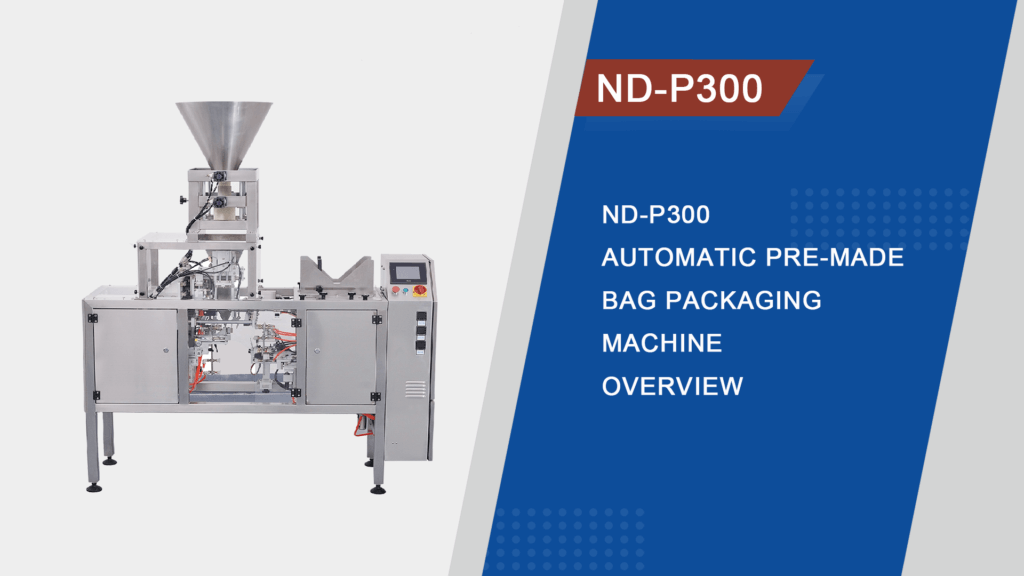amazing cases: ND-P300 prefabricated bags packaging machine in norway
Prefabricated bags packaging machine ND-P300 selected process
With the accelerated pace of consumption in the market, more and more industries are choosing to upgrade their products through packaging to highlight their position in the market. Prefabricated bag packaging is widely welcomed by various industries due to its beautiful and diverse bag shapes, as well as a wide range of available styles.
Prefabricated bag packaging machine in Norway is shared today, where the customer’s products are roasted coffee beans and coffee powder. The customer needs to package up to 6 product specifications and hopes to save costs as much as possible. This means that he needs a device with strong compatibility that can simultaneously meet the requirements of particle and powder packaging. At the same time, it is also necessary to maximize cost savings.
After comparing the characteristics of vertical packaging machines and prefabricated bags packaging machine in various aspects, we have determined a preliminary plan for the packaging equipment: the ND-P300 prefabricated bags packaging machine plan.

Firstly, with the determination of the plan, customers have reduced their packaging speed requirements and increased their requirements for bag types. This premise is the basis for us to reach a preliminary consensus.
The determination of prefabricated bags packaging machine plan follows the following process:
1. Determine the type of host. 2. Determine the cutting method. 3. Determine the complete equipment configuration plan.
1.Determine the host type: The determination of the host type is the determination of the customer’s bag type requirements, namely the size and style of the bag. The width and length of the five types of packaging bags for customers must meet the technical specifications of the P300 model: bag length 120-300mm, bag width 80-280mm. At the same time, there are the following requirements for packaging bags: self standing bags with zippers, with coding function.
2.Determine the blanking method: Because the customer needs to use one machine to package coffee beans and coffee powder by changing the blanking system, we have equipped him with a movable electronic scale and screw blanking system. By using an independent control system and a mobile body, customers can freely change the combination of packaging lines. At the same time, a distributed control system is connected between the blanking system and the host to achieve plug and play functionality.
3.Complete equipment configuration: Centered on the host, combined with an electronic scale and Z-type elevator, to form a fully automatic coffee bean packaging line. Equipped with a screw cutting system and a screw loading machine, it forms a fully automatic coffee powder packaging line. Implement one machine for multiple purposes.
There are several key points to note in Prefabricated bags packaging machine
1. Coffee powder weighing multiple grams cannot be accurately measured with one screw, and different specifications of screws need to be measured separately, otherwise the accuracy requirements cannot be met.
2. The coding position of the code printer is limited. In this case, the code printer selected is a ribbon coding machine, with a maximum of 12 digits per line, printed at the bottom corner of the bag and arranged vertically.
3. There are 5 types of bag sizes for customers, corresponding to five different weights ranging from 150 grams to 1 kilogram. The host needs to install a bag support mechanism to ensure the load-bearing capacity of the 1 kilogram bag.
4. The customer’s bag has a zipper, and the zipper mechanism needs to be arranged in advance. The length and distance from the bag opening of the zipper need to be provided by the customer, so that the machine can arrange the position of the mechanism in advance.
The ND-P300 can be packaged in three sided sealed flat bags, self standing bags, zippered bags, M bags, and flat bottom bags. Through the combination of different measuring systems, it can meet the fully automatic packaging requirements for particles, powders, sauces, liquids, etc. This machine has a compact structure and a small footprint, specifically developed for the packaging application of various composite film prefabricated bags, with reasonable movements. Adopting a touch type color touch screen interface for operation, with a bag placed above and adjustable orientation, it can operate multiple bag types and sizes on a single machine, making switching simple and reducing workload.
The ND-P300 adopts PLC control, triggered by an electromagnetic valve, driven by a cylinder for operation, and monitored by sensors online for operation. Soft suction cups are used to complete the main effective actions such as bag picking, conveying, and opening. Emergency stop and vacuum sensing functions are set to ensure stable, smooth, and safe operation.
The ND-P300 can operate in conjunction with various types of feeding and weighing equipment, and is suitable for different material packaging needs, such as granular materials, powders, sauce liquids, and other food and non food products. The weighing equipment is controlled by the host PLC and is easy to connect. It can adjust the host movement mode and cutting time according to different material properties and packaging quantities to achieve the best packaging effect.
The ND-P300 can provide packaging speeds ranging from 6 to 15 packages per minute, with a reasonable cost performance ratio. Generally, 1-2 workers can work to ensure its smooth operation. This is particularly suitable for small and medium-sized users who have limited workshop space, limited packaging volume, upgraded packaging process automation, but do not want to invest a large amount of supporting funds.
After the ND-P300 was put into use in Norway, after a short period of debugging and running in, customers quickly mastered the operating essentials and were able to proficiently switch between electronic scales and screw metering systems, achieving the goals of minimum investment and maximum output.
